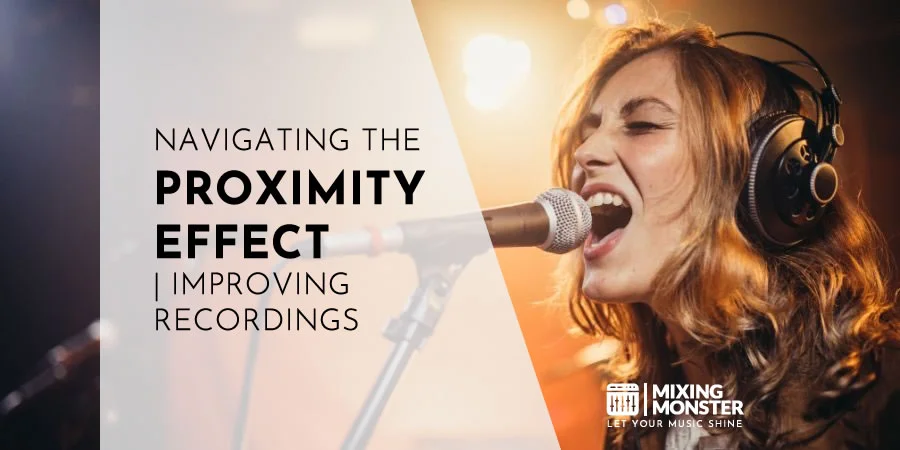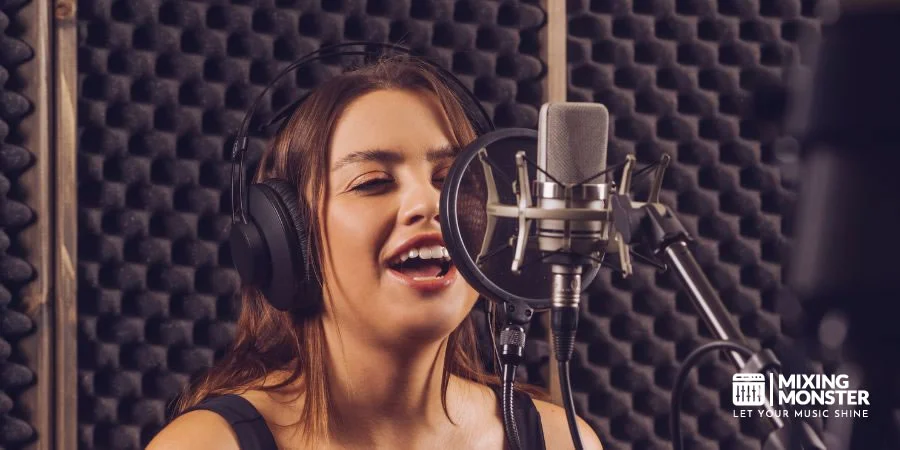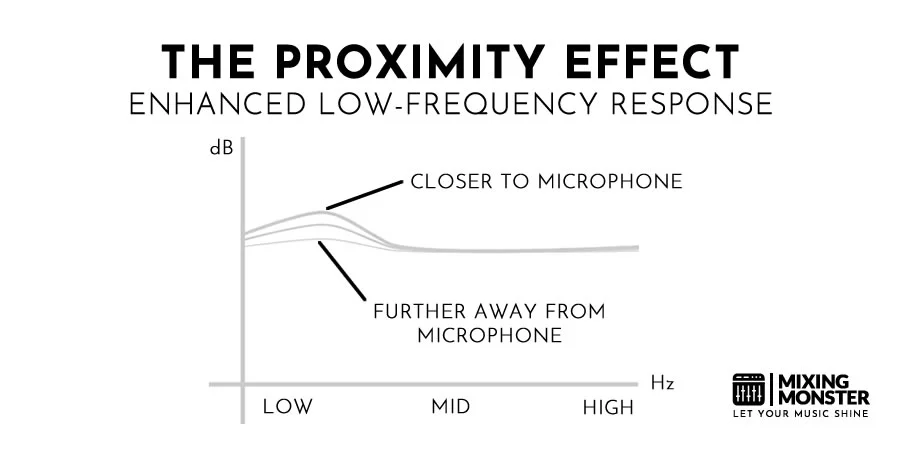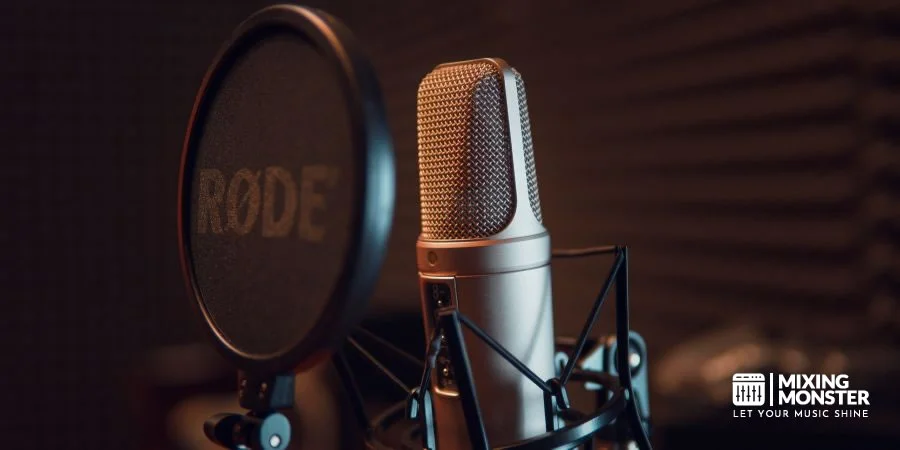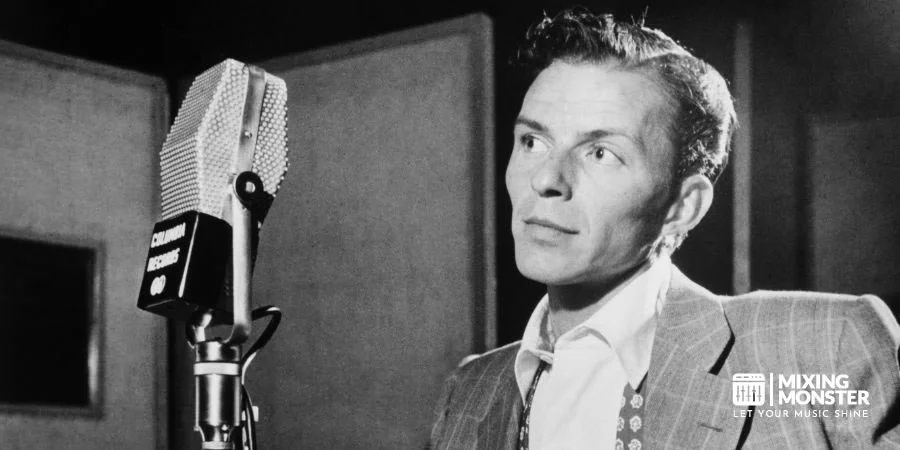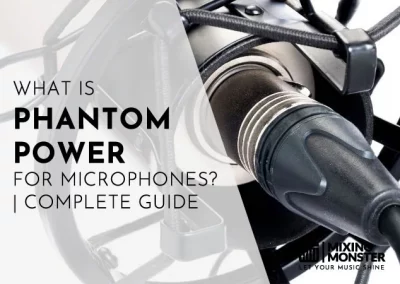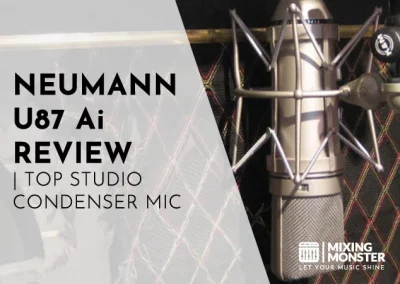Home > Blog > Recording > Recording Insights
Affiliate Disclaimer: We may earn a commission if you purchase through our links
The proximity effect in audio recording is a phenomenon that can significantly impact the quality and character of your captured sound. This article will explore the science behind the effect, its implications for various microphone types, and provide tips for leveraging or mitigating it to achieve the desired audio results.
The proximity effect in audio recording refers to a change in a microphone’s frequency response, resulting in enhanced low-frequency output, as the sound source moves closer to the mic. Predominantly observed in pressure gradient microphones, this phenomenon can be utilized creatively or managed to prevent muddiness and unnatural balance in recordings.
The proximity effect can dramatically influence the tonality of your audio recordings, adding warmth and richness to vocals and instruments. Discover how understanding and controlling this phenomenon can transform your recording sessions and bring your audio to life.
Table Of Contents
1. What Is The Proximity Effect?
2. Technical Background Of The Proximity Effect
3. Microphone Types And The Proximity Effect
4. Benefits Of The Proximity Effect In Audio Recording
5. Challenges Of The Proximity Effect In Audio Recording
6. Tips For Managing The Proximity Effect
7. Examples Of the Proximity Effect In Music
8. The Importance Of Understanding The Proximity Effect

1. What Is The Proximity Effect?
The proximity effect is a phenomenon in audio recording where the low-frequency response of a microphone increases as the sound source moves closer to the microphone.
This effect occurs primarily in directional microphones, such as those with cardioid, supercardioid, or figure-eight polar patterns, due to their pressure gradient design.
As the sound source gets closer to the microphone, the bass frequencies become more pronounced, adding warmth and depth to the recording.
Imagine you’re recording a vocalist for a new song in a professional studio. You’ve set up a high-quality cardioid condenser microphone in an acoustically treated vocal booth.
The singer starts by standing about a foot away from the microphone and begins singing the first verse. At this distance, the microphone captures a clear and balanced sound, with an even representation of the singer’s voice across the frequency spectrum.
As the vocalist moves on to the chorus, they instinctively lean closer to the microphone, now only a few inches away. This is when the proximity effect comes into play.
Due to the pressure gradient design of the cardioid microphone, the closer the singer gets, the more pronounced the bass frequencies become in the recording. The vocals suddenly gain warmth and depth, which can create a more intimate and powerful sound, perfect for the emotional chorus.
However, if the singer gets too close to the microphone, the proximity effect may become overwhelming, resulting in a boomy, muddy sound that lacks clarity.
This is where understanding and managing the proximity effect becomes crucial.
By instructing the singer on proper microphone technique and adjusting the distance between them and the microphone, the engineer can leverage the proximity effect to enhance the recording, while avoiding any negative impact on the overall sound quality.
While the proximity effect can be beneficial for certain applications, such as enhancing the richness of a vocal or instrument, it can also lead to an unnatural balance between low and high frequencies, resulting in a muddy or boomy sound.
2. Technical Background Of The Proximity Effect
The proximity effect in audio recording is a result of the physics and acoustics associated with pressure gradient microphones, which are designed to capture sound based on the difference in sound pressure between the front and rear sides of the microphone diaphragm.
This design principle is employed in microphones with directional polar patterns such as cardioid, supercardioid, hypercardioid, and figure-eight, as they are specifically designed to capture sound based on pressure gradients.
The proximity effect arises due to the way pressure gradient microphones respond to sound waves at different frequencies.
At higher frequencies, sound waves have a shorter wavelength, allowing the pressure difference between the front and rear of the diaphragm to be more easily detected, even when the sound source is farther away.
However, at lower frequencies, the longer wavelengths mean that a more significant phase difference is required for the microphone to detect a pressure gradient.
As the sound source moves closer to the microphone, this phase difference becomes more pronounced, causing the microphone to have an increased sensitivity to low-frequency sounds.
This enhanced low-frequency response is what leads to the proximity effect, where bass frequencies become more prominent as the sound source gets closer to the microphone.
The effect is more noticeable in directional microphones because their polar patterns are specifically designed to be more sensitive to the pressure gradient, while omnidirectional microphones, which rely on pressure rather than pressure gradient, do not exhibit the proximity effect to a significant degree.
To wrap things up, the proximity effect is caused by the inherent design of pressure gradient microphones, which are more sensitive to low-frequency sounds when the sound source is close.

3. Microphone Types And The Proximity Effect
There are three main types of microphones used in audio recording: dynamic, condenser, and ribbon. Each type has unique characteristics that affect how they respond to the proximity effect.
- Dynamic Microphones:
Dynamic microphones use a diaphragm attached to a coil of wire, which is suspended within a magnetic field. When sound waves hit the diaphragm, the coil moves, generating an electrical signal. Dynamic microphones are known for their durability and ability to handle high sound pressure levels. They are often used for live sound reinforcement and in situations where robustness is essential.
Dynamic microphones with directional polar patterns, such as cardioid, can exhibit the proximity effect.
However, due to their generally less sensitive and less extended low-frequency response compared to condenser and ribbon microphones, the proximity effect may be less pronounced in some dynamic microphones.
- Condenser Microphones:
Condenser microphones use a charged diaphragm placed close to a metal backplate. As sound waves hit the diaphragm, the distance between the diaphragm and backplate changes, causing a variation in capacitance, which generates an electrical signal. Condenser microphones typically have a more sensitive and extended frequency response compared to dynamic microphones. They require an external power source, such as phantom power or a battery, to operate.
Condenser microphones with directional polar patterns can also exhibit the proximity effect. Due to their more sensitive and extended low-frequency response, the proximity effect can be more noticeable and pronounced in condenser microphones compared to dynamic microphones.
- Ribbon Microphones:
Ribbon microphones use a thin, corrugated ribbon of metal suspended within a magnetic field. Sound waves cause the ribbon to move, generating an electrical signal. Ribbon microphones are known for their smooth, natural frequency response and excellent transient response. They tend to be more delicate and susceptible to damage from high sound pressure levels or physical shock.
Ribbon microphones with figure-eight polar patterns inherently exhibit a pronounced proximity effect.
The pressure gradient design of these microphones, combined with their smooth, extended low-frequency response, makes them more susceptible to the effect than dynamic and condenser microphones with the same polar patterns.
On average, all three types of microphones can be affected by the proximity effect, but the degree to which they are affected depends on the microphone’s design, polar pattern, and frequency response characteristics.
Ribbon microphones are generally more susceptible to the proximity effect, followed by condenser microphones, while dynamic microphones may exhibit a less pronounced effect.
Here are some examples of microphones featuring different polar patterns, types, and designs, along with a brief description of their relationship to the proximity effect. Keep in mind that the specific relationship may vary depending on the individual microphone model and design.
The Proximity Effect In Different Microphones:
| Polar Pattern | Microphone Type | Example Microphone | Relationship to Proximity Effect |
|---|---|---|---|
| Cardioid | Dynamic | Shure SM58 | Moderate proximity effect; bass frequencies increase as the sound source moves closer. |
| Cardioid | Condenser | Neumann TLM 103 | Pronounced proximity effect due to sensitive and extended low-frequency response. |
| Supercardioid | Dynamic | Beyerdynamic M88 | Moderate to pronounced proximity effect; bass response increases with closer sound source. |
| Supercardioid | Condenser | Rode NTG3 | More pronounced proximity effect compared to cardioid microphones due to narrower pickup pattern and sensitive low-frequency response. |
| Hypercardioid | Dynamic | Electro-Voice RE20 | Pronounced proximity effect due to tight directional pickup pattern; bass frequencies increase as the sound source moves closer. |
| Hypercardioid | Condenser | Audio-Technica AT4053b | Even more pronounced proximity effect than supercardioid microphones due to tighter directional pickup and sensitive low-frequency response. |
| Figure-Eight | Ribbon | Royer Labs R-121 | Strong proximity effect due to distinct front and rear pickup pattern and smooth, extended low-frequency response. |
| Figure-Eight | Condenser | AKG C414 XLS | Pronounced proximity effect due to its figure-eight polar pattern and sensitive low-frequency response. |
Please note that the proximity effect is influenced not only by polar pattern and microphone type but also by factors such as the specific microphone design and construction. Therefore, individual microphones may exhibit varying degrees of proximity effect even within the same category.

4. Benefits Of The Proximity Effect In Audio Recording
The proximity effect, despite being considered a challenge in some recording situations, can also be employed creatively to enhance the sound of vocals and instruments. Some of the positive aspects of the proximity effect include:
Benefits Of The Proximity Effect:
- Increased Bass Response:
As the sound source moves closer to the microphone, the low-frequency response becomes more pronounced. This can be beneficial in adding depth and warmth to certain instruments, like an acoustic guitar or a bass drum, providing a fuller, richer sound. - Vocal Warmth And Presence:
For vocal recordings, the proximity effect can be used to give the voice a more intimate and warm character, which may be desirable for certain genres or styles, such as ballads or voiceovers. By moving closer to the microphone, the vocalist can take advantage of the enhanced low-frequency response to create a more engaging and emotional performance. - Intimacy And Proximity:
The proximity effect can be used to create a sense of intimacy and proximity in a recording, making the listener feel closer to the sound source. This can be particularly effective in genres like ASMR or audiobooks, where the feeling of closeness to the speaker is an essential aspect of the listening experience. - Emphasizing Specific Elements:
In a mix with several instruments, utilizing the proximity effect can help emphasize a particular instrument or vocal part that might otherwise be lost or overshadowed. By carefully positioning the microphone and sound source, engineers can use the proximity effect to create depth and dimension in the mix. - Creative Sound Shaping:
The proximity effect can be employed as a creative tool for sound shaping and sculpting. Engineers and producers can experiment with different microphone placements and distances to achieve unique tonal qualities and textures that enhance the overall sound of a recording.
While the proximity effect can introduce challenges, such as muddiness and unnatural balance, understanding its characteristics and leveraging them creatively can lead to enhanced sound quality and captivating audio experiences.

5. Challenges Of The Proximity Effect In Audio Recording
The proximity effect, while offering some creative benefits, can also introduce potential issues to a recording if not managed properly. Some of the challenges it may present include:
Disadvantages Of The Proximity Effect:
- Muddiness:
As the sound source moves closer to the microphone, the bass frequencies become more pronounced, which can lead to a muddy sound. This muddiness can obscure important details and diminish the clarity of the recording, making it less enjoyable to listen to. - Plosives:
When a vocalist gets too close to the microphone, plosive sounds, such as “p” and “b,” can cause an unwanted low-frequency pop or thump in the recording. This can be distracting and unpleasant for the listener, and may require additional editing or processing to mitigate. - Unnatural Sound Balance:
The proximity effect can create an unnatural balance between low and high frequencies, resulting in a recording that sounds boomy, boxy, or overly bass-heavy. This imbalance can make it difficult to achieve a proper mix and may require significant equalization or filtering to correct. - Inconsistent Sound:
If a vocalist or instrumentalist moves closer to and further from the microphone during a recording session, the resulting audio can exhibit an inconsistent tonality due to the varying proximity effect. This can make it challenging to achieve a cohesive sound and may require additional editing, processing, or even re-recording.
It’s important to understand the potential challenges associated with the proximity effect and employing proper microphone placement.
6. Tips For Managing The Proximity Effect
Minimizing or controlling the proximity effect during recording sessions can be achieved through a combination of techniques, equipment, and post-processing adjustments. Here are some practical suggestions to manage the proximity effect:
How To Manage The Proximity Effect:
- Microphone Placement:
Position the microphone at an appropriate distance from the sound source to minimize the proximity effect. For vocals, a distance of 6-12 inches (15-30 cm) is usually recommended, though this may vary depending on the microphone and desired sound. Experiment with different distances and angles to find the sweet spot that balances the desired warmth and presence with minimal muddiness. - Pop Filters:
Using a pop filter can help reduce plosives and create a physical barrier that encourages the vocalist to maintain a consistent distance from the microphone. This can help minimize variations in the proximity effect and lead to a more consistent and balanced recording. - High-Pass Filtering:
Applying a high-pass filter during recording or in post-production can help mitigate the proximity effect by attenuating low-frequency content. This can help remove any excessive bass buildup and restore a more natural balance to the recording. Start with a gentle slope, like 6 or 12 dB per octave, and adjust the filter’s cutoff frequency as needed to achieve the desired sound. - Equalization:
Use equalization to reduce low-frequency build-up and correct any tonal imbalances introduced by the proximity effect. A parametric EQ can be useful in identifying problematic frequencies and making precise adjustments. Experiment with different EQ settings to find the optimal balance between warmth and clarity. - Consistent Performance:
Encourage performers to maintain a consistent distance from the microphone during recording sessions. This can help minimize fluctuations in the proximity effect and ensure a more even tonality throughout the recording. Providing visual cues, like marking the floor or using a pop filter, can help guide performers. - Choose The Right Microphone:
Select a microphone with a polar pattern and design that is less susceptible to the proximity effect or better suited to the specific recording situation. For example, an omnidirectional microphone may be less prone to the proximity effect and could be a better choice for certain applications. - Room Acoustics:
Pay attention to the acoustics of the recording space, as room reflections can interact with the proximity effect, either reinforcing or mitigating its impact. A well-treated room with proper absorption and diffusion can help achieve a more balanced and controlled sound.
By employing these techniques and adjusting as needed based on the specific recording scenario, you can minimize or control the proximity effect and achieve a high-quality, balanced sound that meets your creative goals.

7. Examples Of the Proximity Effect In Music
The proximity effect has been influencing the audio recording domain ever since. Here are a few examples illustrating how the proximity effect has been effectively utilized or managed in professional recordings:
Examples Of The Proximity Effect In Music:
- Frank Sinatra:
Frank Sinatra was known for his remarkable vocal control and microphone technique. He would move closer to the microphone to emphasize the warmth and intimacy of his voice during quieter passages and then pull back during louder parts to maintain a balanced and consistent sound. By using the proximity effect to his advantage, Sinatra was able to create a dynamic and emotive performance that still resonates with listeners today.
- ASMR Recordings:
ASMR (Autonomous Sensory Meridian Response) recordings often make use of the proximity effect to create a heightened sense of intimacy and presence. ASMR artists position their microphones close to their mouths or other sound sources, capturing the enhanced low-frequency response and creating a soothing and immersive listening experience. This deliberate use of the proximity effect has become a defining characteristic of the ASMR genre. - Radio Broadcasters:
Radio broadcasters have long been aware of the proximity effect and use it to their advantage to create a warm, resonant voice that commands attention. By positioning themselves close to the microphone, radio personalities can achieve a rich, full-bodied sound that cuts through background noise and ensures their voice is clearly heard by listeners. - The Beatles – “Blackbird”:
In the recording of “Blackbird” from The Beatles’ White Album, Paul McCartney’s acoustic guitar is recorded with a pronounced low-end warmth, which is likely the result of the proximity effect. The close-miking technique used during the recording session captures the intimacy and warmth of the guitar, contributing to the song’s timeless appeal. - David Bowie – “Heroes”:
The recording of David Bowie’s “Heroes” features an innovative approach to managing the proximity effect. Producer Tony Visconti set up three microphones at different distances from Bowie – one close, one at medium distance, and one far away. As Bowie’s performance grew louder, the close microphone would be gated off, and the other microphones would pick up his voice. This technique allowed them to maintain a consistent sound balance while also utilizing the proximity effect to emphasize Bowie’s powerful vocals.
These examples demonstrate how artists and producers can harness the proximity effect for creative purposes or effectively manage it to achieve a desired sound.
By understanding the phenomenon and implementing appropriate microphone techniques and post-processing adjustments, the proximity effect can be a valuable tool for creating unique and captivating audio experiences.
8. The Importance Of Understanding The Proximity Effect
In conclusion, the proximity effect in audio recording is a phenomenon that can present both challenges and opportunities for artists, engineers, and producers.
By understanding the underlying physics, acoustics, and microphone characteristics that contribute to the effect, professionals can make informed decisions about microphone placement, technique, and post-processing adjustments.
While the proximity effect can introduce issues like muddiness, plosives, and unnatural sound balance, it can also be harnessed creatively to add warmth, depth, and intimacy to recordings.
By effectively managing and utilizing the proximity effect, audio professionals can achieve a wide range of tonal qualities and textures that enhance the listening experience and contribute to the success of their recordings.


